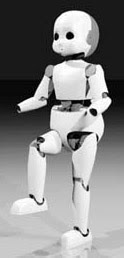Robots, the topic has been fascinating all of us for years. Latest and path-breaking research has been making this more interesting. Various types of robots have always been attracting people of all ages.
Walking robots also keep giving new challenges to the scientists who work harder to improve the working of walking robots. Let’s understand the concept behind this type of robots.
Making the robots walk is a complicated technical procedure. Many of the walking robots can walk reliably on two legs; however none have yet been made which are as robust as a human.
Many other robots have been built that walk on more than two legs, due to these robots being significantly easier to construct. Hybrids too have been proposed in movies such as I, Robot, where they walk on 2 legs and switch to 4 (arms+legs) when going to a sprint.
Typically, robots on 2 legs can walk well on flat floors and can occasionally walk up stairs. None can walk over rocky, uneven terrain. Some of the methods which have been tried are:
ZMP Technique:
The Zero Moment Point (ZMP) is the algorithm used by robots such as Honda's ASIMO. The robot's onboard computer tries to keep the total inertial forces (the combination of earth's gravity and the acceleration and deceleration of walking), exactly opposed by the floor reaction force (the force of the floor pushing back on the robot's foot). In this way, the two forces cancel out, leaving no moment (force causing the robot to rotate and fall over.
However, this is not exactly how a human walks, and the difference is obvious to human observers, some of whom have pointed out that ASIMO walks as if it needs the lavatory. ASIMO's walking algorithm is not static, and some dynamic balancing is used. However, it still requires a smooth surface to walk on.
Hopping:
Several robots, built in the 1980s by Marc Raibert at the MIT Leg Laboratory, successfully demonstrated very dynamic walking. Initially, a robot with only one leg, and a very small foot, could stay upright simply by hopping. The movement is the same as that of a person on a pogo stick. As the robot falls to one side, it would jump slightly in that direction, in order to catch itself. Soon, the algorithm was generalised to two and four legs. A bipedal robot was demonstrated running and even performing somersaults. A quadruped was also demonstrated which could trot, run, pace, and bound. For a full list of these robots, see the MIT Leg Lab Robots page.
Dynamic Balancing or controlled falling:
A more advanced way for a robot to walk is by using a dynamic balancing algorithm, which is potentially more robust than the Zero Moment Point technique, as it constantly monitors the robot's motion, and places the feet in order to maintain stability. This technique was recently demonstrated by Anybots' Dexter Robot,which is so stable, it can even jump. Another example is the TU Delft Flame.
Passive Dynamics:
Perhaps the most promising approach utilizes passive dynamics where the momentum of swinging limbs is used for greater efficiency. It has been shown that totally unpowered humanoid mechanisms can walk down a gentle slope, using only gravity to propel them.
Using this technique, a robot need only supply a small amount of motor power to walk along a flat surface or a little more to walk up a hill. This technique promises to make walking robots at least ten times more efficient than ZMP walkers, like ASIMO.
Source 



